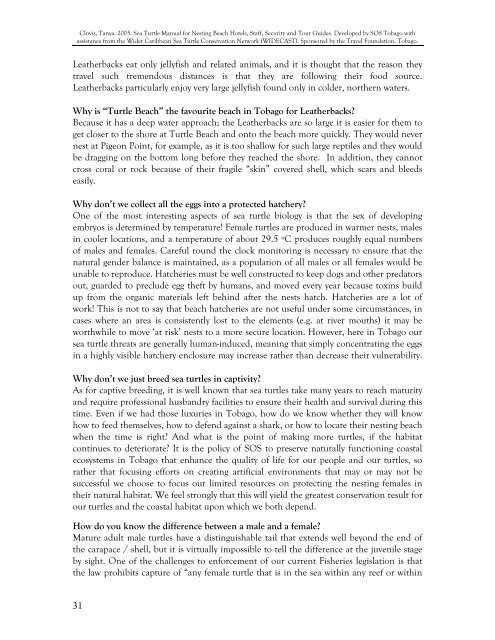Clovis, Tanya. - WIDECAST
Clovis, Tanya. - WIDECAST
Clovis, Tanya. - WIDECAST
You also want an ePaper? Increase the reach of your titles
YUMPU automatically turns print PDFs into web optimized ePapers that Google loves.
<strong>Clovis</strong>, <strong>Tanya</strong>. 2005. Sea Turtle Manual for Nesting Beach Hotels, Staff, Security and Tour Guides. Developed by SOS Tobago with<br />
assistance from the Wider Caribbean Sea Turtle Conservation Network (<strong>WIDECAST</strong>). Sponsored by the Travel Foundation. Tobago.<br />
Leatherbacks eat only jellyfish and related animals, and it is thought that the reason they<br />
travel such tremendous distances is that they are following their food source.<br />
Leatherbacks particularly enjoy very large jellyfish found only in colder, northern waters.<br />
Why is “Turtle Beach” the favourite beach in Tobago for Leatherbacks<br />
Because it has a deep water approach; the Leatherbacks are so large it is easier for them to<br />
get closer to the shore at Turtle Beach and onto the beach more quickly. They would never<br />
nest at Pigeon Point, for example, as it is too shallow for such large reptiles and they would<br />
be dragging on the bottom long before they reached the shore. In addition, they cannot<br />
cross coral or rock because of their fragile “skin” covered shell, which scars and bleeds<br />
easily.<br />
Why don’t we collect all the eggs into a protected hatchery<br />
One of the most interesting aspects of sea turtle biology is that the sex of developing<br />
embryos is determined by temperature! Female turtles are produced in warmer nests, males<br />
in cooler locations, and a temperature of about 29.5 ºC produces roughly equal numbers<br />
of males and females. Careful round the clock monitoring is necessary to ensure that the<br />
natural gender balance is maintained, as a population of all males or all females would be<br />
unable to reproduce. Hatcheries must be well constructed to keep dogs and other predators<br />
out, guarded to preclude egg theft by humans, and moved every year because toxins build<br />
up from the organic materials left behind after the nests hatch. Hatcheries are a lot of<br />
work! This is not to say that beach hatcheries are not useful under some circumstances, in<br />
cases where an area is consistently lost to the elements (e.g. at river mouths) it may be<br />
worthwhile to move ‘at risk’ nests to a more secure location. However, here in Tobago our<br />
sea turtle threats are generally human-induced, meaning that simply concentrating the eggs<br />
in a highly visible hatchery enclosure may increase rather than decrease their vulnerability.<br />
Why don’t we just breed sea turtles in captivity<br />
As for captive breeding, it is well known that sea turtles take many years to reach maturity<br />
and require professional husbandry facilities to ensure their health and survival during this<br />
time. Even if we had those luxuries in Tobago, how do we know whether they will know<br />
how to feed themselves, how to defend against a shark, or how to locate their nesting beach<br />
when the time is right And what is the point of making more turtles, if the habitat<br />
continues to deteriorate It is the policy of SOS to preserve naturally functioning coastal<br />
ecosystems in Tobago that enhance the quality of life for our people and our turtles, so<br />
rather that focusing efforts on creating artificial environments that may or may not be<br />
successful we choose to focus our limited resources on protecting the nesting females in<br />
their natural habitat. We feel strongly that this will yield the greatest conservation result for<br />
our turtles and the coastal habitat upon which we both depend.<br />
How do you know the difference between a male and a female<br />
Mature adult male turtles have a distinguishable tail that extends well beyond the end of<br />
the carapace / shell, but it is virtually impossible to tell the difference at the juvenile stage<br />
by sight. One of the challenges to enforcement of our current Fisheries legislation is that<br />
the law prohibits capture of “any female turtle that is in the sea within any reef or within<br />
31
















